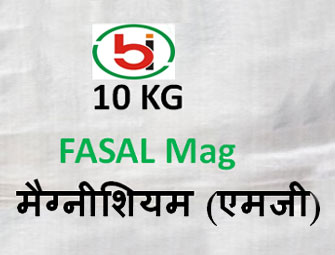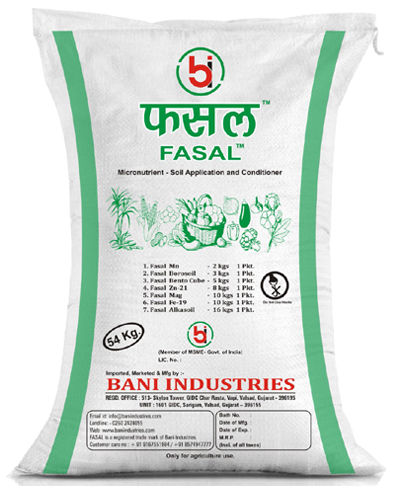- Message us on Whatsapp
 9967864055 / 9167551984
9967864055 / 9167551984- baniindustries513@gmail.com
Our Products
AGRO CHEMICAL - FASAL
AGRO CHEMICAL - FASALTM
Micronutrients : There are 7 essential plant nutrient elements defined as micronutrients [boron (B), zinc (Zn), manganese (Mn), iron (Fe), gypsum (Caso4), Bentonite (b)]. They constitute in total less than 1% of the dry weight of most plants (Crops). The following nutrient (literature)) focuses primarily on the soil characteristics for the micronutrients.

a. boron (B)
Fasal Fine Borax: 10.5% 3 kg per acer land
For any given crop when boron is recommended, a high rate of boron may be required on: 3 KG
• clay-type soils
• soils that are high in water pH and/or calcium content
• high organic matter content soils
• soils where boron is broadcast versus boron being either banded or foliar applied
List of Boron-containing Commercial Fertilizers:
Source Formula % B Content Borax Na2B4O7. 10H2O 11 Boric Acid H3BO3 16 Solubor Na2B4O7. 4H2O + Na2B10O16. 10H2O 20

b. zinc (Zn)
Fasal Z-21: 21% zn 10% 5 to 10 kg per acer land
Zinc is included in the Standard Soil Test. The level of soil zinc is “insufficient” or “low” when extractable zinc is less than 2.0 pounds per acre and the soil pH is less than 6.1, and when extractable zinc is less than 2.5 pounds per acre and the soil pH greater than 6.0.
Soil pH Extractable Zinc lbs per acre < 5.9 > 5 < 6.0 > 11 < 6.1 > 21 < 6.2 > 31 < 6.3 > 41 > 6.2 > 51

c. manganese (Mn)
Fasal Super Mn: 30.5% Mn 12% Sulphur 2 to 5 kg per acer land
Manganese is included in the Standard Soil Test. Manganese deficiency is most likely to occur in soybean, peanut, oat, wheat, and cotton grown on soils in Soil Groups 1, 2 and 3 in Area 5 and on some poorly drained soils in Area 4 when the soil pH is high (>6.0 or 6.5, depending on soil type).

d. iron (Fe)
Fasal Fine Fe-19: 12% iron 9 % sulphur 4 to 10 kg per acer land
In most cases, plant iron deficiency is not due to the lack of iron in the soil, but due to soil conditions that reduce its plant availability, such as:
• high soil pH
• low soil oxygen levels caused by either soil compactions or water- logging
• prolonged periods of excessive soil moisture
• high temperatures
• high soil phosphorus, copper, manganese, and zinc levels

e. gypsum (Caso4)
Fasal Super Alkasol: 21% calcium, 18% sulphur, 4% palas (K2O), 2% magnesium-10 to 16 kg per acer land
Gypsum (Calcium Sulphate) is among the best-known soil conditioners, and it helps farmers to improve their soil structure. This type of fertilizer contains all the nutrients required for your plants' growth. Gypsum gets deep in the soil layers very quickly and provides the needed calcium and sulphur.

f. magnesium (Mg)
Fasal Super Mag: 9.6% Magnesium, 10% Sulphur-10 kg per acer land
Although magnesium (Mg) is an essential element for plant growth, its use in a fertilizer program For most of the state, this lack of emphasis is justifiable because when management properly, most soils contain sufficient Mg to meet crop needs. If Mg is limited in the diet, animals can develop grass tetany. Therefore, some special consideration is given to the Mg status of forage crops
Magnesium is the central core of the chlorophyll molecule in plant tissue. Thus, if Mg is deficient, the shortage of chlorophyll results in poor and stunted plant growth.
Magnesium also helps to activate specific enzyme systems. Enzymes are complex substances that build, modify, or break down compounds as part of a plant's normal metabolism.

g. Bentonite (b)
Fasal Bento Cube: Granules natural enzyme, humic acid, amino acid and natural minerals- 5 to 10 kg per acer land
Bentonite is an excellent natural sealant mostly used for landfills, sealing recreational ponds, and sewage lagoons. It is one of the most economical methods for treating porous soils. It absorbs a high amount of water and is able to swell 15 times. The clay is used as liner material, binder, and water-proofing building materials. Bentonite is also recognized as an external detoxifier.

Zinc Sulphate Mono Hydrate 33%
Borax (Sodium Tetra Borate) (B: 10.5%)
Copper Sulphate 24 %
Ammonium Molybdate Mo: 52)
Boric Acid (B-17%)
Zinc Oxide
Chelated EDTA
Chelated Calcium 9%
Chelated Copper 12%
Chelated Magnesium 6%
Chelated Manganese 6%
Chelated Zinc 12%
Chelated Iron 12%
FE EDDHA 6%

Sulphur based
Sulphur dusting powder (85%)
Sulphur WDG 90% / WP 80%
Bentonite Sulphur Granular 90%
Sulphur Liquid 25%
Potassic based
Potassium Chloride
Potassium Sulphate
Potassium Schoenite

